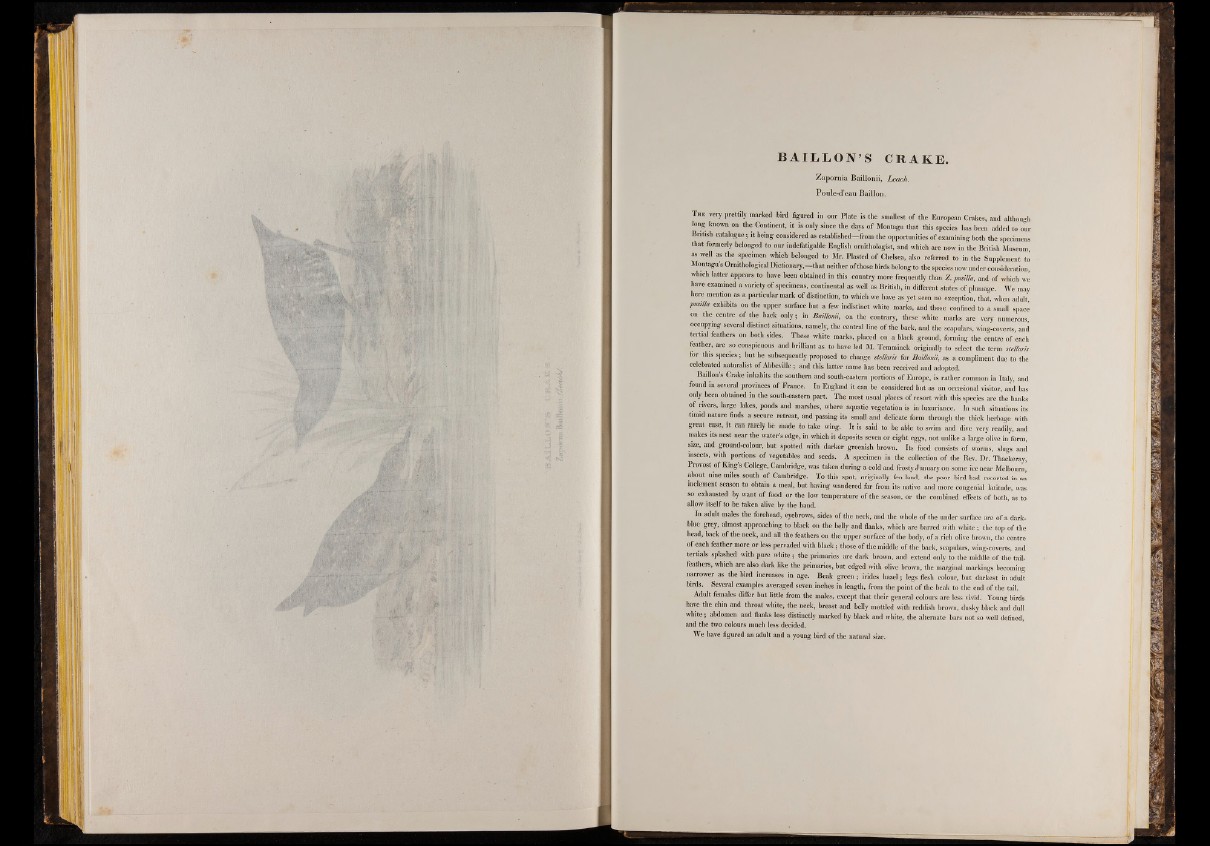
B A I L LO N’ S CRAKE.
Z a p o rn ia Ba illonii, L ea ch .
Pou le-d ’eau Bail Ion.
The very prettily marked bird figured in oar Plate is the smallest o f the European Crakes, and although
long knot™ on the Continent, it is only since the days o f Montagu that this species has been added to our
British catalogue; it being considered as established— from the opportunities o f examining both the specimens
that formerly belonged to our indefatigable English ornithologist, and which are now in the British Museum,
as well as the specimen which belonged to Mr. Plasted o f Chelsea, also referred to in the Supplement to
Montagu's Ornithological Dictionary,— that neither o f those birds belong to the species now under
which latter appears to have been obtained in this country more frequently than Z .p u silla , and o f which we
have examined a variety o f specimens, continental as well as British, in different states o f plumage. We may
here mention as a particular mark o f distinction, to which we have as yet seen no exception, that, when adult,
pm illa exhibits on the upper surface but a few indistinct white marks, and those confined to a small space
on the centre o f the back only 5 in Baillonii, on the contrary, these white marks are very numerous,
occupying several distinct situations, namely, the central line o f the back, and the scapulars, wing-coverts, and
tertial feathers on both sides. These white marks, placed on a black ground, forming the centre o f each
feather, are so conspicuous and brilliant as to have led M. Temminck originally to select the term stellar is
for this species; but he subsequently proposed to change stellam for BaiHomi, as a compliment due to the
celebrated naturalist o f Abbeville ; and this latter name has been received and adopted.
Baillon’s Crake inhabits the southern and south-eastern portions o f Europe, is rather common in Italy, and
found in several provinces o f France. In England it can be considered but as an occasional visitor, and has
only *)een obtained in the south-eastern part. The most usual places o f resort with this species are the banks
o f rivers, large lakes, ponds and maishes, where aquatic vegetation is in luxuriance. In such situations its
timid nature finds a secure retreat, and passing its small and delicate form through the thick herbage with
great ease, it can rarely be made to take wing. It is said to be able to swim and dive very readily, and
makes its nest near the water’s edge, in which it deposits seven or eight eggs, not unlike a large olive in form,
size, and ground-colour, but spotted with darker greenish brown. Its food consists o f worms, slugs and
insects, with portions o f vegetables and seeds. A specimen in the collection o f the Rev. Dr. Thackeray,
Provost o f King’s College, Cambridge, was taken during a cold and frosty January on some ice near Melboum]
about nine miles south Of Cambridge. To this spot, originally fen land, the poor bird had resorted in an
inclement season to obtain a meal, but having wandered far from its native and more congenial latitude, was
so exhausted by want o f food or the low temperature o f the season, or the combined effects o f both, as to
allow itself to be taken alive by the hand.
In adult males the forehead, eyebrows, sides o f the neck, and the whole o f the under surface are o f a dark-
blue grey, almost approaching to black on the belly and flanks, which are barred with white ; the top o f the
head, back o f the neck, and all the feathers on the upper surfitce o f the body, o f a rich olive brown, the centre
o f each feather more or less pervaded with black; those o f the middle o f the back, scapulars, wing-coverts, and
tertials splashed with pure white ; the primaries are dark brown, and extend only to the middle o f the tail-
feathers, which are also dark like the primaries, but edged with olive brown, the marginal markings becoming
narrower as the bird increases in age. Beak green ; irides hazel; legs flesh colour, but darkest in adult
birds. Several examples averaged seven inches in length, from the point o f the. beak to the end o f the tail.
Adult females differ but little from the males, except that their general colours are less vivid. Young birds
have the chin and throat white, the neck, breast and belly mottled with reddish brown, dusky black and dull
white; abdomen and flanks less distinctly marked by black and white, the alternate bars not so well defined,
and the two colours much less decided.
We have figured an adult and a young bird o f the natural size.